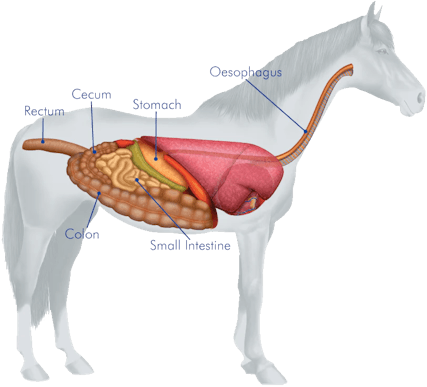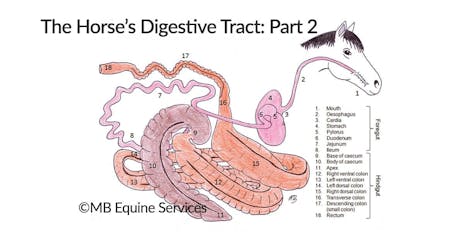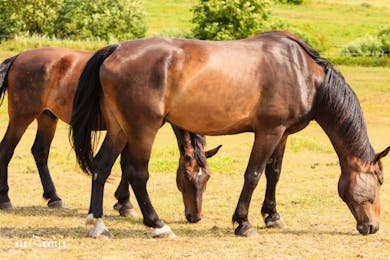small intestine info...

The small intestine is a crucial part of a horse's digestive system, where the majority of nutrient absorption takes place. Here's some information about a horse's small intestine:
Location and Length of the small intestine...
The small intestine is a long, tubular organ located between the stomach and the large intestine. In horses, the small intestine is relatively large and measures approximately 60 to 70 feet (18 to 21 meters) in length. Its length allows for a more extensive surface area, essential for efficient nutrient absorption.
Structure and Segments...
The small intestine is divided into three segments: the duodenum, jejunum, and ileum. The duodenum is the shortest segment and connects to the stomach. The jejunum and ileum follow, and they are the primary sites for nutrient absorption, where the breakdown products of food are absorbed into the bloodstream.
Nutrient Absorption of the intestine...
The inner lining of the small intestine is composed of numerous finger-like projections called villi, which further increase the surface area for nutrient absorption. The villi are covered with microvilli, forming a brush border that facilitates the absorption of nutrients such as carbohydrates, proteins, fats, vitamins, and minerals.The process of nutrient absorption is vital for providing the horse with essential nutrients necessary for growth, energy production, and overall health. Here's some added information about nutrient absorption in the intestine of horses:
Small Intestine Structure: The small intestine in horses consists of three segments: the duodenum, jejunum, and ileum. Each segment has a specific role in nutrient absorption. The inner lining of the small intestine is lined with numerous finger-like projections called villi, which are covered with microvilli, forming a brush border. This extensive surface area is where nutrient absorption primarily takes place.
Passage of Chyme...
After the stomach partially digests the ingested food, it is released into the small intestine in a semi-liquid form called chyme. As the chyme moves through the small intestine, digestive enzymes from the pancreas and bile from the liver are released to further break down the food into smaller molecules for absorption.
Cecum and Hind gut Fermentation...
The horse's cecum, a large pouch-like structure, is also considered part of the digestive system. While the majority of nutrient absorption occurs in the small intestine, the cecum is involved in hind gut fermentation, breaking down fibrous material (cellulose) with the help of symbiotic microorganisms to extract additional nutrients.
Sensitive Digestive System...
Horses have a sensitive digestive system that is optimised for continuous grazing and consuming fibrous plant material. Abrupt changes in diet or overconsumption of concentrated feeds can lead to digestive issues, such as colic or laminitis. This sensitivity arises from the evolutionary development of their gastrointestinal tract, which is optimised for efficiently processing fibrous plant material. Here's some information about the sensitive digestive system in horses:
Herbivorous Diet: Horses are herbivores, meaning their diet primarily consists of plant-based material, such as grasses and hay. Their digestive system is designed to extract nutrients from fibrous plant material through a process of fermentation.
Digestive Efficiency...
Horses have evolved as herbivores with a digestive system designed to extract nutrients from fibrous plant material. They are more efficient at digesting roughage compared to high-starch or high-sugar feeds. Providing horses with a diet that closely resembles their natural grazing behaviour is essential for maintaining digestive health.
Proper management and feeding practices, including a balanced diet and a gradual transition between different feeds, are crucial for supporting the health and functionality of a horse's small intestine and overall digestive system. Regular access to forage (hay or pasture) is fundamental in ensuring a healthy gut and optimal nutrient absorption.





